
Ulexite (NaCaB5O6(OH)6·5H2O, hydrated sodium calcium borate hydroxide), sometimes known as TV rock or television stone, is a mineral occurring in silky white rounded crystalline masses or in parallel fibers. The natural fibers of ulexite conduct light along their long axes, by internal reflection. Ulexite was named for the German chemist Georg Ludwig Ulex (1811–1883) who first discovered it.
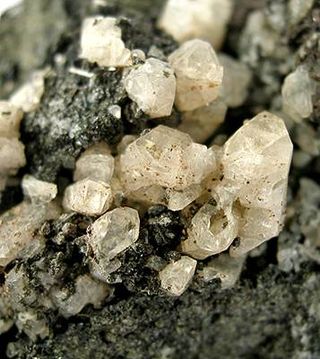
Anorthite is the calcium endmember of the plagioclase feldspar mineral series. The chemical formula of pure anorthite is CaAl2Si2O8. Anorthite is found in mafic igneous rocks. Anorthite is rare on the Earth but abundant on the Moon.

Rhodochrosite is a manganese carbonate mineral with chemical composition MnCO3. In its pure form (rare), it is typically a rose-red colour, but it can also be shades of pink to pale brown. It streaks white, and its Mohs hardness varies between 3.5 and 4.5. Its specific gravity is between 3.45 and 3.6. It crystallizes in the trigonal system, and cleaves with rhombohedral carbonate cleavage in three directions. The crystal structure of rhodochrosite is a rhombohedral system, which is a subset of the trigonal system. The carbonate ions (CO3) are arranged in a triangular planar configuration, and the manganese ions (Mn) are surrounded by six oxygen ions in an octahedral arrangement. The MnO6 octahedra and CO3 triangles are linked together to form a three-dimensional structure. Crystal twinning often is present. It is often confused with the manganese silicate, rhodonite, but is distinctly softer. Rhodochrosite is formed by the oxidation of manganese ore, and is found in South Africa, China, and the Americas. It is officially listed as one of the National symbols of Argentina.

Niter or nitre is the mineral form of potassium nitrate, KNO3. It is a soft, white, highly soluble mineral found primarily in arid climates or cave deposits.

Vaterite is a mineral, a polymorph of calcium carbonate (CaCO3). It was named after the German mineralogist Heinrich Vater. It is also known as mu-calcium carbonate (μ-CaCO3). Vaterite belongs to the hexagonal crystal system, whereas calcite is trigonal and aragonite is orthorhombic.
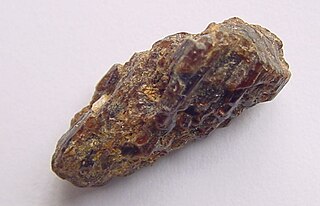
Painite is a very rare borate mineral. It was first found in Myanmar by British mineralogist and gem dealer Arthur C.D. Pain who misidentified it as ruby, until it was discovered as a new gemstone in the 1950s. When it was confirmed as a new mineral species, the mineral was named after him. Due to its rarity, painite can cost between US$50,000 to $60,000 per carat.

Ludwigite is a magnesium-iron borate mineral: Mg2FeBO5.
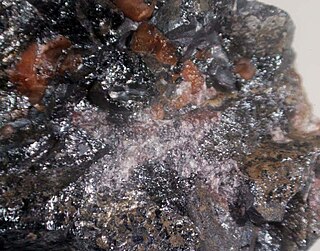
The rare mineral adelite, is a calcium, magnesium, arsenate with chemical formula CaMgAsO4OH. It forms a solid solution series with the vanadium-bearing mineral gottlobite. Various transition metals substitute for magnesium and lead replaces calcium leading to a variety of similar minerals in the adelite - duftite group.
Aeschynite-(Nd) is a rare earth mineral of neodymium, cerium, calcium, thorium, titanium, niobium, oxygen, and hydrogen with the chemical formula (Nd,Ce,Ca,Th)(Ti,Nb)2(O,OH)6. Its name comes from the Greek word for "shame". Its Mohs scale rating is 5 to 6. It is a member of the hydroxide minerals.

Whewellite is a mineral, hydrated calcium oxalate, formula Ca C2O4·H2O. Because of its organic content it is thought to have an indirect biological origin; this hypothesis is supported by its presence in coal and sedimentary nodules. However, it has also been found in hydrothermal deposits where a biological source appears improbable. For this reason, it may be classed as a true mineral.

Andersonite, Na2Ca(UO2)(CO3)3·6H2O, or hydrated sodium calcium uranyl carbonate is a rare uranium carbonate mineral that was first described in 1948. Named after Charles Alfred Anderson (1902–1990) of the United States Geological Survey, who first described the mineral species, it is found in sandstone-hosted uranium deposits. It has a high vitreous to pearly luster and is fluorescent. Andersonite specimens will usually glow a bright lemon yellow (or green with blue hints depending on the deposit) in ultraviolet light. It is commonly found as translucent small rhombohedral crystals that have angles close to 90 degrees although its crystal system is nominally trigonal. Its Mohs hardness is 2.5, with an average specific gravity of 2.8.
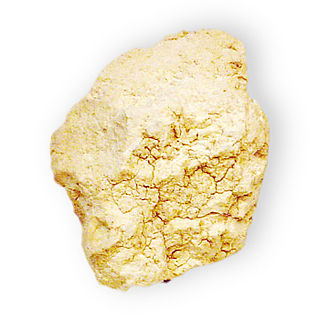
Hectorite is a rare soft, greasy, white clay mineral with a chemical formula of Na0.3(Mg,Li)3Si4O10(OH)2.

Howlite, a calcium borosilicate hydroxide (Ca2B5SiO9(OH)5), is a borate mineral found in evaporite deposits.
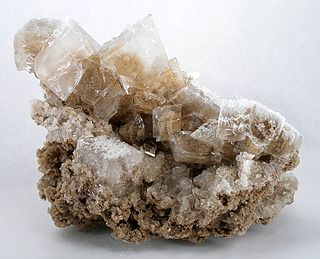
Meyerhofferite is a hydrated borate mineral of calcium, with the chemical formula Ca2B6O6(OH)10·2H2O, CaB3O3(OH)5·H2O or Ca2(H3B3O7)2·4H2O. It occurs principally as an alteration product of inyoite, another borate mineral.
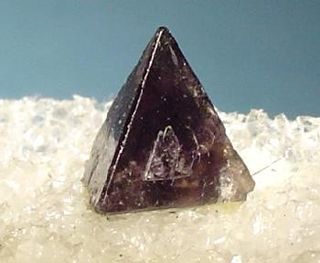
Chambersite is a manganese borate mineral with formula Mn3B7O13Cl. It is a member of the borate mineral series that includes other minerals such as ericaite and boracite. When chambersite was first discovered, it was the second chemical analogue of boracite to be found in nature. It was discovered as a mineral at Barber's Hill salt dome in Texas in 1957 and in 1971 at the Dongshuichang deposit in Jixian, Tianjin, China. Chambersite occurs associated with the evaporite minerals halite, anhydrite, and gypsum.

Roselite is a rare arsenate mineral with chemical formula: Ca2(Co,Mg)[AsO4]2·H2O. It was first described in 1825 for an occurrence in the Rappold mines of Schneeberg, Saxony, Germany and named by Armand Lévy after German mineralogist Gustav Rose. It occurs in cobalt bearing hydrothermal environments and was associated with veins of quartz and chalcedony in the type locality. It has also been reported from Italy, Morocco, Chile, British Columbia and several locations in Germany.

Studenitsite is a rare borate mineral with chemical formula of NaCa2[B9O14(OH)4]·2H2O.
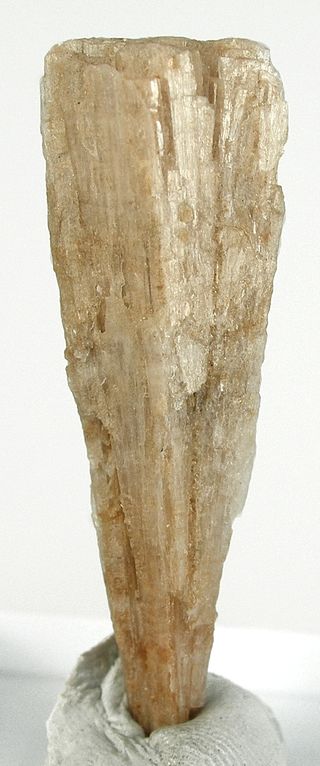
Syngenite is an uncommon potassium calcium sulfate mineral with formula K2Ca(SO4)2·H2O. It forms as prismatic monoclinic crystals and as encrustations.

Earlandite, [Ca3(C6H5O7)2(H2O)2]·2H2O, is the mineral form of calcium citrate tetrahydrate. It was first reported in 1936 and named after the English microscopist and oceanographer Arthur Earland FRSE. Earlandite occurs as warty fine-grained nodules ca. 1 mm in size in bottom sediments of the Weddell Sea, off Antarctica. Its crystal symmetry was first assigned as orthorhombic, then as monoclinic, and finally as triclinic.
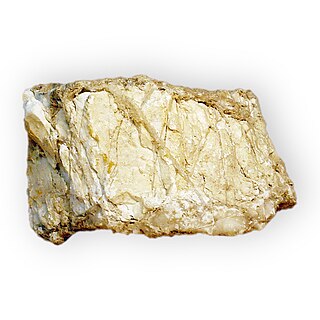
Priceite is a white borate mineral. The mineral has been found in places such as Chetco, Oregon, Death Valley, and northwestern Turkey. In 1862 small amounts of this mineral were mined from Chetco, Oregon.



















